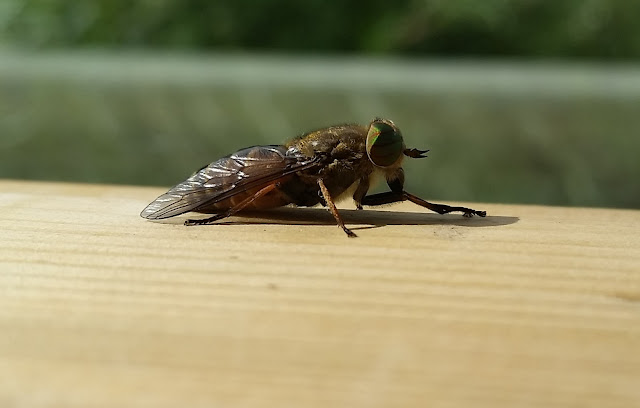In way of a change we all parked at the main car park and
spent a superb five hours ambling along the Orange Trail (taking in the bridal
path Emperor alley) and clocked up an impressive 23 species.
Small Skipper
|
Comma
|
Essex Skipper
|
Silver Washed Fritillary
|
Large Skipper
|
Speckled Wood
|
Brimstone
|
Marbled White
|
Large White
|
Ringlet
|
Small White
|
Gatekeeper
|
Green-veined White
|
Meadow Brown
|
White Admiral
|
Purple Hairstreak
|
Purple Emperor
|
White-letter Hairstreak
|
Painted Lady
|
Common Blue
|
Peacock
|
Holly Blue
|
Small Tortoiseshell
|
 |
| White Admiral |
 |
| Painted Lady |
 |
| Gatekeeper |
 |
| Small Tortoiseshell - Nick Smith |
 |
| Large White - Nick Smith |
 | |
| Meadow Brown |
The Silver Washed Frits were stunning and we even saw a pale silvery valezina female as they came down to nectar with an immaculate White Letter Hairstreak while countless Ringlets and gliding White Admirals danced in the glades. The Purple Emperors were a bit tricky and only a handful of us saw one from several powerglides through the Oak canopy.
A Hummingbird Hawk Moth tore up the path like a kid on a scooter and Six Spot Burnets and Silver-Y moths were seen in the grassland along with Dark Bush Crickets and a solitary Pyramidal Orchid.
 |
| Silver Washed Frit - Mark vale |
 |
| White Admiral |
 | |
| White Admiral |
 | |
| Small Skipper |
 |
| Large Skipper |
 | |
| Comma |
I have never seen so many hoverflies nectaring on Thistle (Creeping, Marsh & Spear), Teasel, Ragwort, Meadowsweet and Knapweed. Episyrphus balteatus and Syrphus sp numbered in the 1000's and I am happy that there were many banded Epistrophes ... and some Eupeodes corollae but I cannot be more certain.
 | |
| Episyrphus balteatus |
 |
| Eristalis arbustorum |
 |
| Scaeva pyrastri |
Also seen were Eristalis pertinax, Eristalis nemorum, Eristalis tenax, Eristalis arbustorum, Volucella pelucens, Platycheirus sp, Helophilus pendulus, Scaeva pyrastri, Cheilosia illustrata, Spaerophoria scripta and a superb Sericomyia silentis.
 |
| Hoverfly Bar |
 |
| Syprhus sp but not sure.... not ribisii as black hind femur... I think |
Dragons and Damsels did not want to be left out and Emperors, Brown and Southern Hawkers were terrorising the glades and rides and many species of butterfly has missing chunks from their wings. Azure, Blue Tail and Common Blue Damsels were picking off smaller prey and buoyant Banded Demoiselles did likewise but in a more graceful manner! Predatory Notch Horned Clegs (Haematopota pluvialis) were laying in wait on the wider rides and rose lazily as we walked along. A few found accessible bits of flesh but although I did lose some blood, I think that my sun tan spray was putting them off!
 |
| Banded Demoiselle - Nick Smith |
 |
| Banded Demoiselle |
 | ||
| Four Spot Chaser |
 | ||
| Female Emperor egg laying |
 |
| Notch Horned Clegs (Haematopota pluvialis) |
 |
| Misumena vitae |
Bird wise the woods were quiet other than an occasional roving tit flock complete with Long-tails, sneezing Marshes, Treecreepers and Nuthatches while overhead a solitary Crossbill ‘gypped’ and the now expected and expectant Red Kites peered down on us from tree top height in the hope that we would either drop something edible or collapse from Clegg related blood loss.
 |
| Lunch time company |
On to the Manton Bay end of Rutland Water for some end of day Osprey action and we were not to be disappointed with a single and three together in the distance as we walked down and the three chicks and both their parents around the nest from the hides. Superb views were had and the male even flew off and came back with a large trout which he deposited for his three scaly youngsters to disassemble. The views from the hide are actually very good and the family is not too far away and the screen in the hide is actually a fine accompaniment as you can then watch what happens after the fish is dropped. One of the bolder kids was even doing practice dives and she has only been flying three days. There were plenty of Coots and Mute Swans as well as Gadwall, Mallard and Tufted Duck broods and a snaky necked Great White Egret stalked among several Little Egrets. Hobby and Buzzard added to the raptor list.
 |
| Cracking Osprey shot by Mark Vale |
 |
| and yes I know I took a picture of the screen but I could see all four in the scope and it was just great to see Osprey family life close up |
 |
| Horse Fly (Hybomitra distinguenda) |
However the best was still to come as we were just following one of the Ospreys who was up having a hover quite close to us when, with a huge roar, the Vulcan Bomber passed over low and slow heading north! Incredible! Mark vale somehow managed a shot of both ‘species’ on the same view... undoubtedly a first...
 | |
| Simply amazing.... well done to Mark and cheers for letting me use it |
 |
| Oncoming trouble... oh and there are five Ospreys in this view too! |
With rain clouds building to the west we headed back along the humid shore and just made it to the cars as the heavens opened in a refreshing deluge. With that it was time to head for home onto a bizarrely empty road network that saw me drop the lads off at Lakeside just over an hour and a half later after a most satisfactory day out in the sticks.




No comments:
Post a Comment